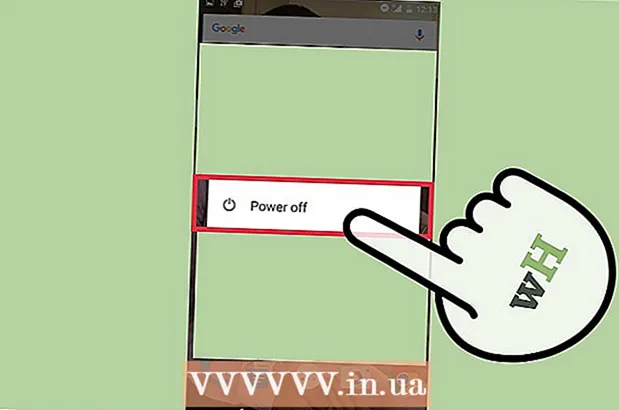Author:
Gregory Harris
Date Of Creation:
13 August 2021
Update Date:
1 July 2024

Content
- Steps
- Part 1 of 3: Veterinary examination
- Part 2 of 3: Ways to give medicine to your guinea pig
- Part 3 of 3: Home Care
In order for a guinea pig to stay healthy, it needs daily care and attention. If your guinea pig develops symptoms such as lack of appetite, wheezing, sneezing, crusty eyes, hunched posture, hair loss, coarse or lumpy hair, diarrhea, blood in the urine, or loss of balance, you should immediately show it to your veterinarian. In the absence of proper veterinary care, the condition of a guinea pig can deteriorate very quickly.
Steps
Part 1 of 3: Veterinary examination
 1 Take your guinea pig to the vet at the first sign of illness. In guinea pigs, the disease often develops very quickly - the animal can die 20 hours after the onset of the disease. If you notice any signs of illness in your pet, contact your veterinarian immediately.
1 Take your guinea pig to the vet at the first sign of illness. In guinea pigs, the disease often develops very quickly - the animal can die 20 hours after the onset of the disease. If you notice any signs of illness in your pet, contact your veterinarian immediately.  2 Discuss the observed symptoms with your veterinarian. Guinea pigs are often sick due to improper care, inappropriate nutrition, or contact with another guinea pig that has an infectious disease. It is important to discuss the symptoms and conditions of the animal with the veterinarian, as this will help to establish the causes of the disease. Guinea pigs are prone to the following ailments and diseases:
2 Discuss the observed symptoms with your veterinarian. Guinea pigs are often sick due to improper care, inappropriate nutrition, or contact with another guinea pig that has an infectious disease. It is important to discuss the symptoms and conditions of the animal with the veterinarian, as this will help to establish the causes of the disease. Guinea pigs are prone to the following ailments and diseases: - Digestive disorders caused by bacteria, viruses or other parasites. However, symptoms such as diarrhea, weight loss, dehydration, lethargy, and decreased appetite are observed.
- Dental problems such as drooling. These problems are associated with abnormal tooth growth, which makes it difficult for the guinea pig to swallow and chew. This can lead to excessive salivation and drooling. In addition, the animal may experience weight loss, bleeding from the mouth, and oral abscesses.
- Eating disorders such as vitamin C deficiency. Like other small mammals, guinea pigs do not produce vitamin C on their own and only get it through food. If the guinea pig does not have enough vitamin C, it becomes lethargic, begins to limp, and it is difficult for it to move.
- Adverse reaction to antibiotics. Guinea pigs are hypersensitive to some antibiotics, and penicillin-based drugs such as amoxicillin are toxic to them. A negative reaction to antibiotics is accompanied by symptoms such as diarrhea, loss of appetite, dehydration, and a decrease in body temperature. Antibiotic poisoning can kill the animal.
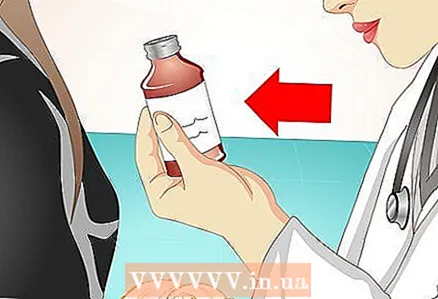 3 Get directions from your veterinarian on how to treat and care for your guinea pig. Your veterinarian will examine your pet, identify symptoms, and prescribe appropriate treatment. Your doctor will also recommend additional care for your guinea pig that will ease the condition and speed up recovery.
3 Get directions from your veterinarian on how to treat and care for your guinea pig. Your veterinarian will examine your pet, identify symptoms, and prescribe appropriate treatment. Your doctor will also recommend additional care for your guinea pig that will ease the condition and speed up recovery. - Make sure your veterinarian does not prescribe any penicillin-based oral medications such as penicillin itself, ampicillin, lincomycin, clindamycin, vancomycin, erythromycin, tylosin, tetracycline, and chlortetracycline as they may harm your guinea pig. Your veterinarian should prescribe antibiotics that will be tolerated by your pet and will not be toxic to your pet.
Part 2 of 3: Ways to give medicine to your guinea pig
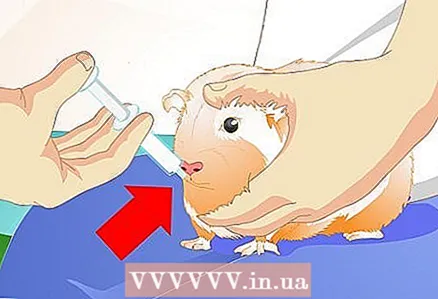 1 Give liquid medicine with a syringe without a needle. Your veterinarian may prescribe liquid medications for a bacterial respiratory infection or indigestion. To give oral fluids to your pet, use a 1 ml (1 cubic centimeter) syringe without a needle. Shake the solution before use, then draw the required amount into the syringe.
1 Give liquid medicine with a syringe without a needle. Your veterinarian may prescribe liquid medications for a bacterial respiratory infection or indigestion. To give oral fluids to your pet, use a 1 ml (1 cubic centimeter) syringe without a needle. Shake the solution before use, then draw the required amount into the syringe. - Place the guinea pig on your lap with its back resting on your stomach. Hold it with your left hand under the belly, and with your index and thumb, grasp the head and jaws of the animal under the eyes. Hold the guinea pig's head firmly so that it cannot move it.
- With your right hand, insert the syringe into the corner of your mouth behind your front teeth. Push the syringe towards your back teeth so that it touches them.
- Slowly squeeze the contents of the syringe into the guinea pig's mouth. Stop squeezing the medicine out of the syringe if the pig stops chewing - chewing indicates that it is swallowing liquid. In this case, wiggle the syringe until the animal starts chewing again, then squeeze out the medicine all the way.
 2 Use a styptic forceps to administer pills to your pet. If you are deficient in vitamin C, your guinea pig may need vitamin C tablets. A hemostatic or hemostatic forceps is used to compress bleeding vessels. You can get this clip from a pharmacy, health care store, or online. It easily passes into the mouth of a guinea pig and is well suited for giving pills in size and shape.
2 Use a styptic forceps to administer pills to your pet. If you are deficient in vitamin C, your guinea pig may need vitamin C tablets. A hemostatic or hemostatic forceps is used to compress bleeding vessels. You can get this clip from a pharmacy, health care store, or online. It easily passes into the mouth of a guinea pig and is well suited for giving pills in size and shape. - Take the guinea pig in the same way as for giving it liquid medicine from a syringe. Using a styptic forceps, slide the pill into her mouth up to her molars. Make sure that the animal makes a chewing motion that indicates that it has swallowed the pill.
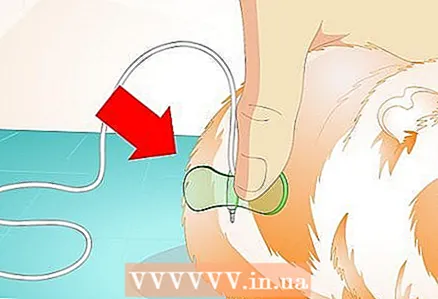 3 Inject subcutaneous fluids using a butterfly catheter. Solutions for subcutaneous use are prescribed if the guinea pig cannot swallow oral medications and fluids. Your veterinarian will show you how to insert a butterfly catheter. Through this catheter, you can administer medications to your pet subcutaneously.
3 Inject subcutaneous fluids using a butterfly catheter. Solutions for subcutaneous use are prescribed if the guinea pig cannot swallow oral medications and fluids. Your veterinarian will show you how to insert a butterfly catheter. Through this catheter, you can administer medications to your pet subcutaneously. 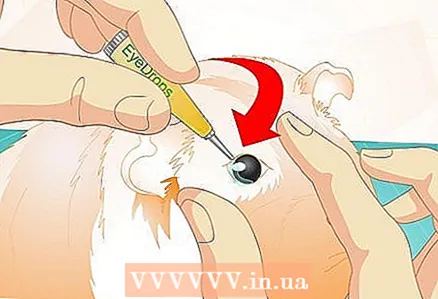 4 To give your guinea pig its eyes, place it on the table with its muzzle away from you. If your pet has eye problems, your veterinarian may prescribe eye drops. Place the guinea pig face down on the table. Then take a vial with a pipette and place it from the back above the animal's head. With the other hand, spread the eyelids to the sides and instill the eye on top. Thus, the animal will not have time to make out the pipette, which can scare it.
4 To give your guinea pig its eyes, place it on the table with its muzzle away from you. If your pet has eye problems, your veterinarian may prescribe eye drops. Place the guinea pig face down on the table. Then take a vial with a pipette and place it from the back above the animal's head. With the other hand, spread the eyelids to the sides and instill the eye on top. Thus, the animal will not have time to make out the pipette, which can scare it.
Part 3 of 3: Home Care
 1 Place the guinea pig on flat, folded towels. Unlike conventional cage filler, towels will allow you to track your pet's urine and stool. In addition, it will be easier for the guinea pig to move around and lie on the towels.
1 Place the guinea pig on flat, folded towels. Unlike conventional cage filler, towels will allow you to track your pet's urine and stool. In addition, it will be easier for the guinea pig to move around and lie on the towels. 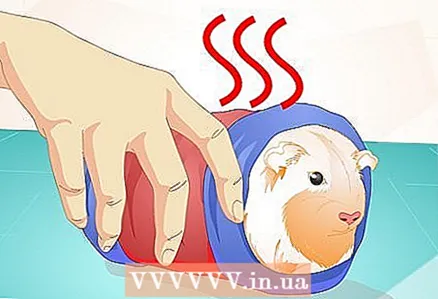 2 Wrap your pet for warmth. During illness, the guinea pig may experience chills. To relieve muscle pain, wrap the animal in a warm cloth. This will help keep your guinea pig warm and relaxed. Make sure that the fabric is not too warm or too tight for the animal.
2 Wrap your pet for warmth. During illness, the guinea pig may experience chills. To relieve muscle pain, wrap the animal in a warm cloth. This will help keep your guinea pig warm and relaxed. Make sure that the fabric is not too warm or too tight for the animal. - You can also fill a bottle with warm water, wrap it in a towel, and place it in the corner of the cage.
- For respiratory or digestive problems, the guinea pig should be kept clean, warm, and calm until it recovers.
 3 Watch your pet's reactions to medications. Make sure that the animal does not get worse from the drugs taken, especially if it is antibiotics. Many antibiotics can cause diarrhea in a guinea pig and upset the balance of bacteria in its intestines. If you notice a negative antibiotic reaction, take your pet to your veterinarian immediately.
3 Watch your pet's reactions to medications. Make sure that the animal does not get worse from the drugs taken, especially if it is antibiotics. Many antibiotics can cause diarrhea in a guinea pig and upset the balance of bacteria in its intestines. If you notice a negative antibiotic reaction, take your pet to your veterinarian immediately. - Most likely, the veterinarian will stop the antibiotics and prescribe a different treatment.
 4 If your guinea pig has no appetite, hand feed it. The disease can lead to loss of appetite, in which case the animal should be hand-fed. Malnutrition can cause your guinea pig to stop urinating and defecating. For successful treatment, it is necessary that the animal eat and drink water during the illness.
4 If your guinea pig has no appetite, hand feed it. The disease can lead to loss of appetite, in which case the animal should be hand-fed. Malnutrition can cause your guinea pig to stop urinating and defecating. For successful treatment, it is necessary that the animal eat and drink water during the illness. - Adult guinea pigs should consume about 6 grams of dry food and drink 10 to 40 ml of water for every 100 grams of their weight. Try hand-feeding your pig with dry food soaked in water with chopped parsley, carrots, and other vegetables. You can also add wheatgrass juice or natural cranberry juice to your liquid feed to whet your appetite.
- When hand-feeding your guinea pig, make sure it is firmly on a level surface or on its stomach. Do not feed your pig when she is lying on her back, as she may choke. You can also place the animal in a small pouch or wrap it in a towel. You may find it more comfortable if you place the guinea pig with its head away from you.
- Take food and hand it to your pet. Feed your pig slowly so that it has time to chew and swallow food properly.
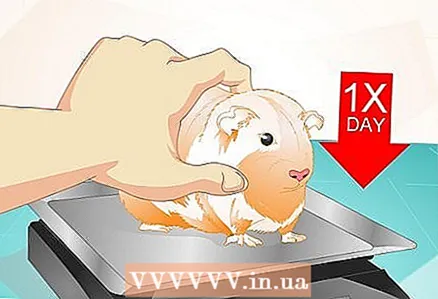 5 Weigh your pet once a day. Monitor your guinea pig's weight and weigh it on a kitchen scale once or twice a day. This way, you can determine if hand feeding is effective and if the animal is recovering and gaining weight after the illness.
5 Weigh your pet once a day. Monitor your guinea pig's weight and weigh it on a kitchen scale once or twice a day. This way, you can determine if hand feeding is effective and if the animal is recovering and gaining weight after the illness. - Record your daily weigh-in to track your recovery.
 6 If your guinea pig hasn't improved, take it to your veterinarian. You should contact your veterinarian again if the treatment has not yielded positive results.
6 If your guinea pig hasn't improved, take it to your veterinarian. You should contact your veterinarian again if the treatment has not yielded positive results.


